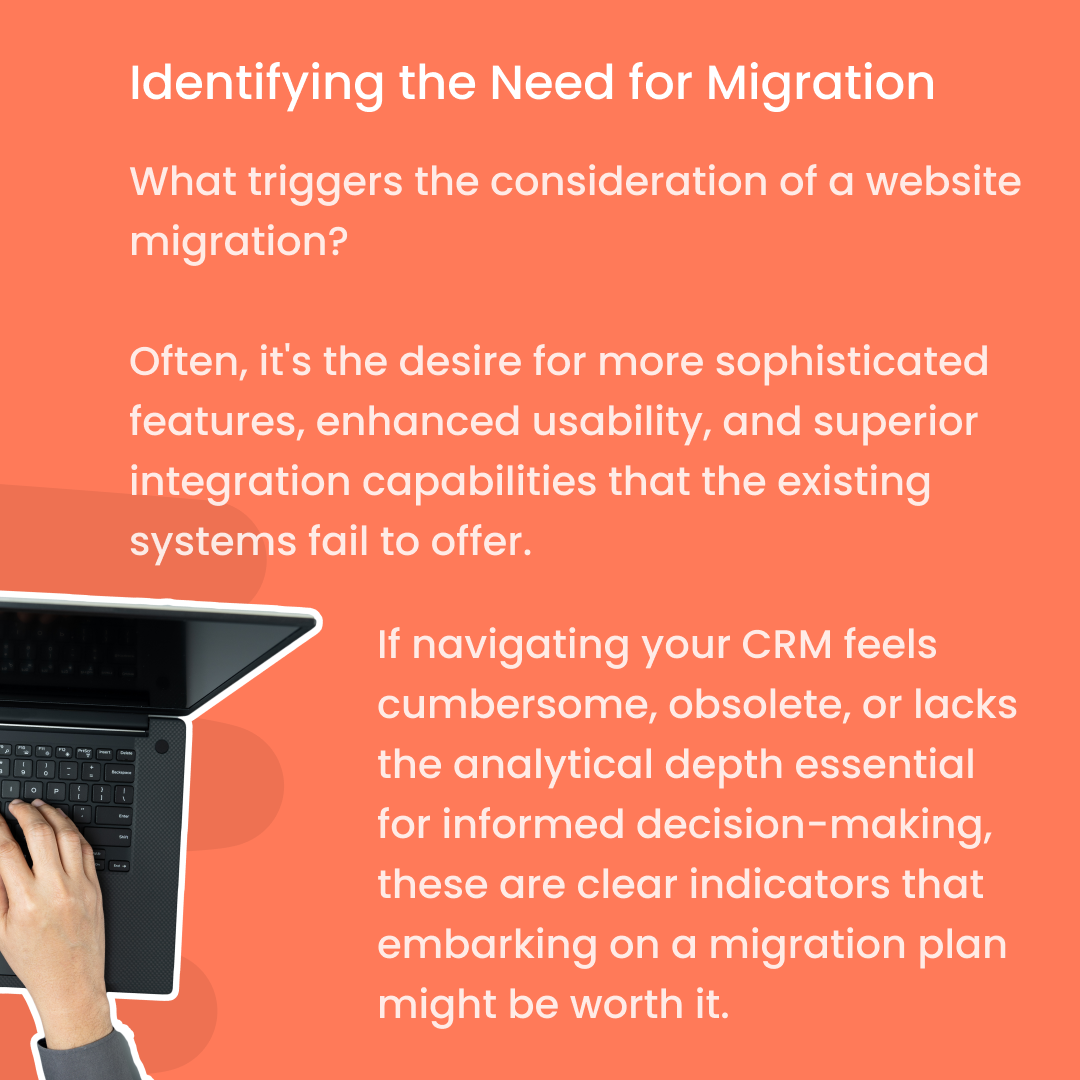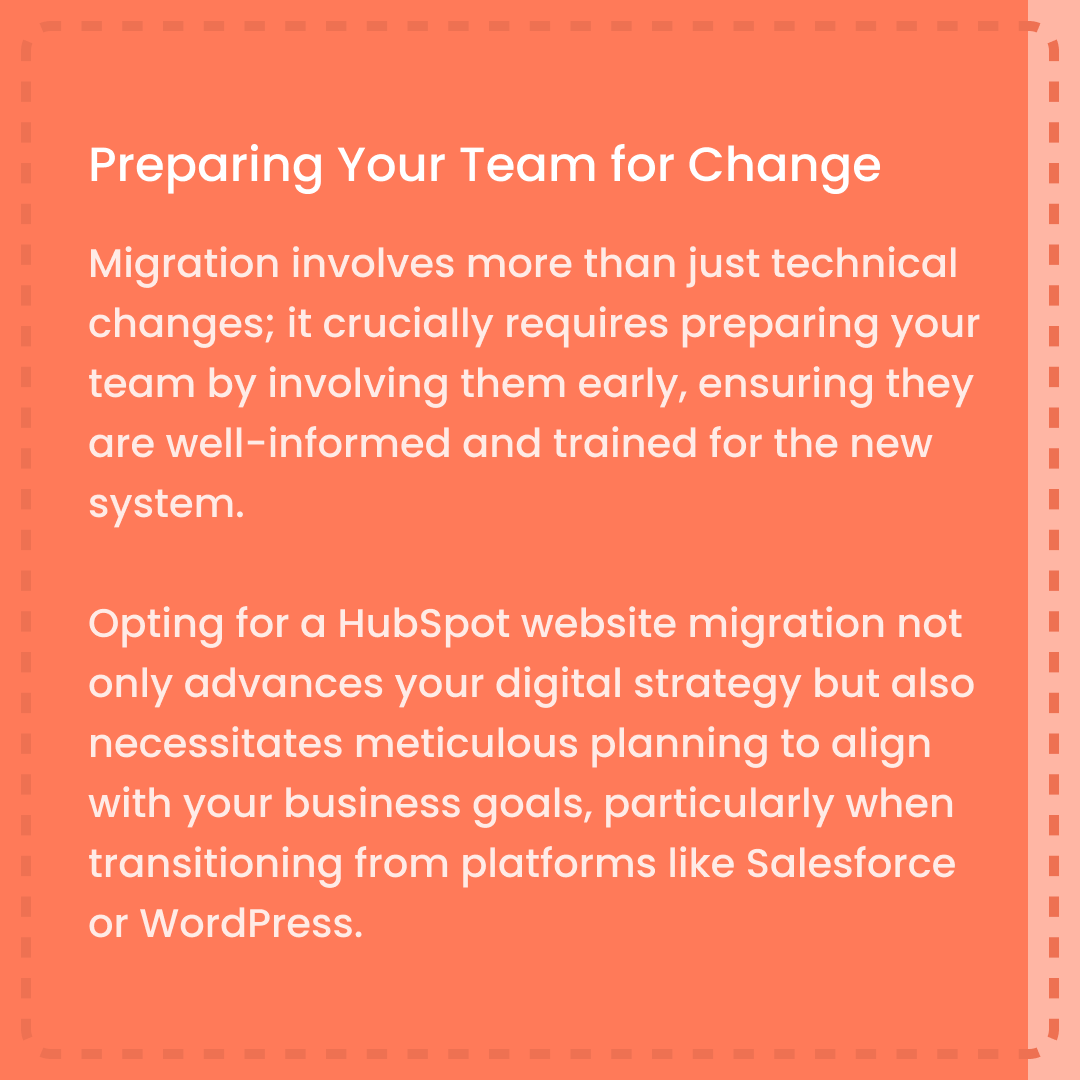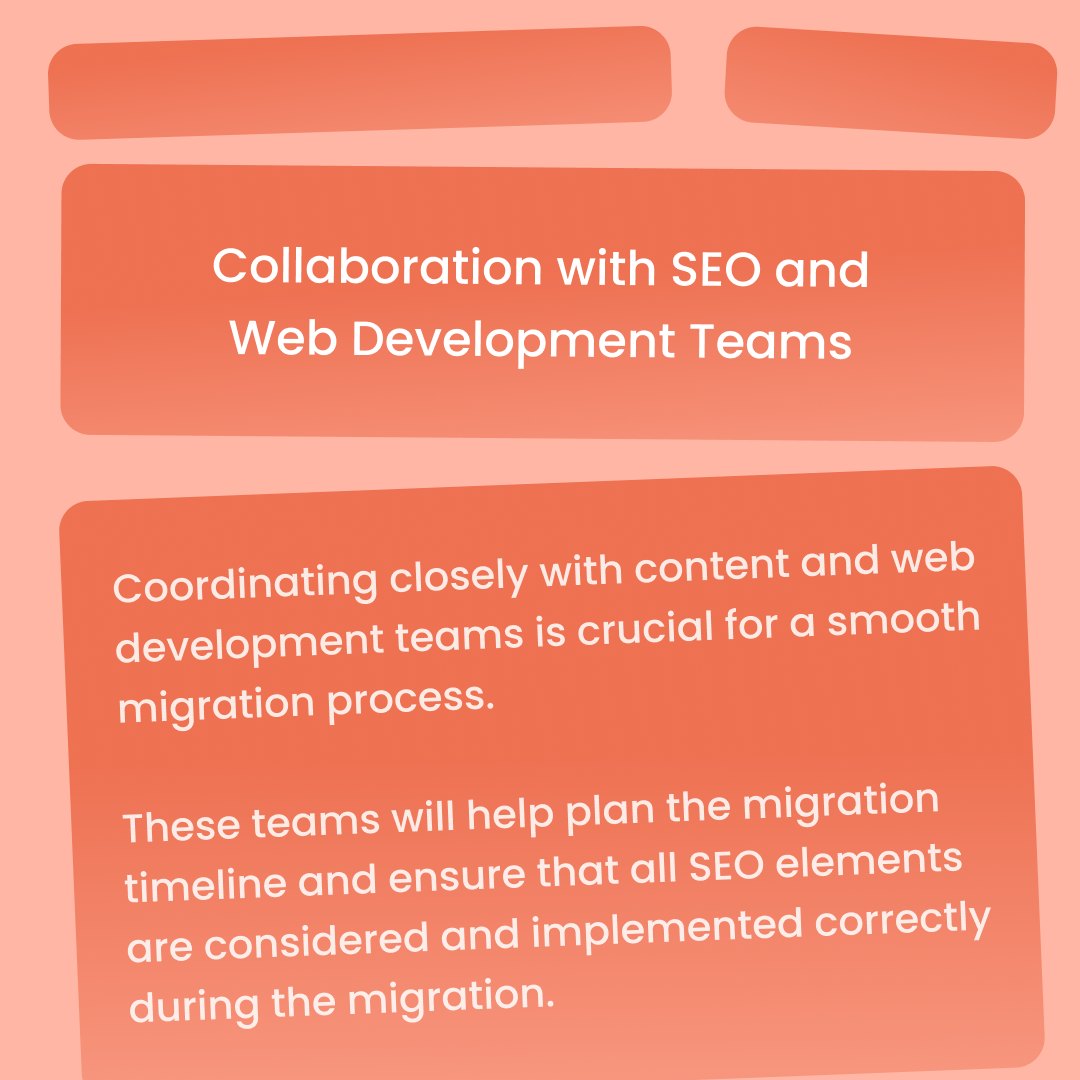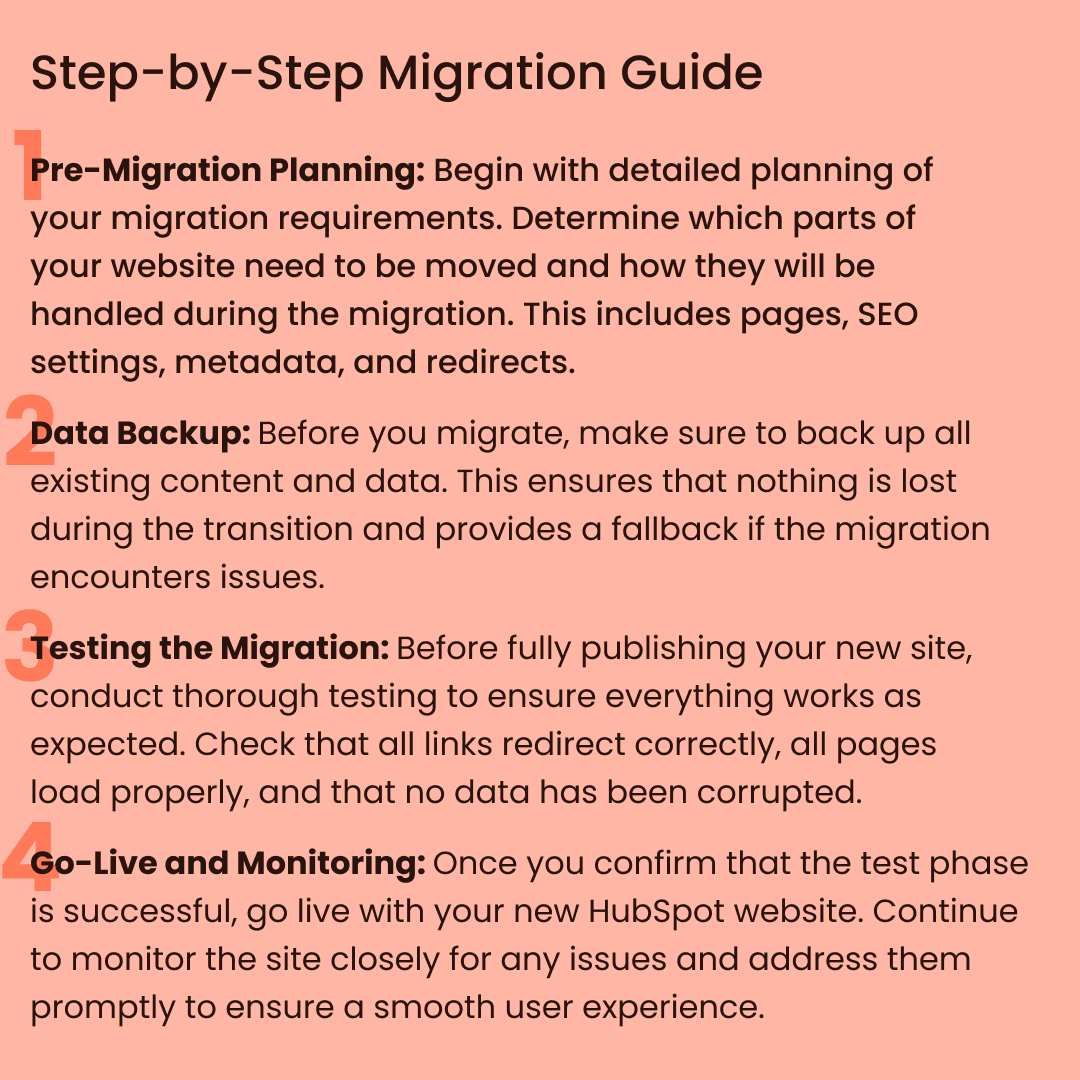Assessing Your Current Website's Migration Readiness for HubSpot CMS
Migrating your website to a new Content Management System (CMS) like HubSpot’s CMS Hub can significantly enhance your digital strategy.
Understanding your website's readiness for such a migration is the first essential step.
Evaluating Your Existing CMS's Performance
Before you even think about making the move to HubSpot CMS, take a good, hard look at how your current CMS is meshing with your business operations.
Ask yourself:
1. Is it making day-to-day tasks easier?
2. Is it helping keep customers happy and coming back for more?
3. Does it streamline the process of managing leads effectively?
A top-notch CMS should feel like it’s part of the team, not just a tool.
It should simplify workflows, enhance your team’s ability to engage with clients, and ensure that leads are nurtured properly through every step of the sales funnel.
If your current system feels more like a roadblock than a runway, it might be time to consider a switch to a more capable platform, like the HubSpot CMS.
Let's face it—working with a clunky, inefficient CMS is like trying to fill a bathtub with a thimble: frustrating, time-consuming, and downright ineffective.
This frustration can ripple across your team, leading to more mistakes, slower response times, and a dip in the quality of customer interactions.
Ultimately, if your CMS isn’t up to par, it’s not just your team that suffers—it’s your customer satisfaction and your bottom line too.
Identifying the Need for CMS Migration

Identifying when it’s time to consider a CMS migration can fundamentally change the trajectory of your business.
Often, the push toward a CMS upgrade is driven by realizing your current system just isn’t cutting it anymore.
You might start feeling the pinch if your CMS lacks the advanced features that modern digital strategies require, or if usability issues are slowing your team down instead of helping them speed up.
Think about the everyday experience with your current CMS.
Does it integrate smoothly with the other tools and systems you use?
Can it adapt as you tweak your marketing strategies, or does it feel like a relic from a bygone digital era?
If you’re constantly running into walls because your CMS can’t handle something as basic as new social media integrations or mobile optimization, it’s a clear sign that you’re due for an upgrade.
Moreover, analytics are the backbone of informed decision-making in any business.
A CMS that doesn’t provide robust analytics capabilities can leave you guessing rather than strategizing.
Without strong insights into how your content performs or how users interact with your site, you’re missing out on crucial data that could drive conversions and enhance engagement.
As your business grows, the stakes get higher.
A scalable CMS like HubSpot becomes essential to meet these increased demands.
HubSpot website migration offers a solution that not only grows with you but also enhances every aspect of your digital presence.
Whether it’s managing larger volumes of content, handling increased traffic, or integrating new marketing tools, HubSpot’s CMS is designed to handle complex needs with ease.
Technical and Strategic Considerations
When planning your HubSpot website migration, the technical audit of your current website is a critical first step.
This involves a thorough evaluation of your site's architecture to ensure that the foundational structure aligns well with HubSpot’s CMS.
Analyzing your data structures is equally important. You need to understand how your data is organized and stored.
This helps in ensuring that no critical data is lost or misaligned during the migration process.
Compatibility with third-party systems is another key area.
Your website might be integrated with various external applications and services, such as email marketing tools, customer relationship management systems, or e-commerce platforms.
Assessing how these integrations will transfer to HubSpot is crucial.
You might find that some custom integrations require redevelopment to work seamlessly with the HubSpot ecosystem.
Planning for these adaptations ahead of time can prevent functionality gaps post-migration.
Custom features and specific functionalities also deserve careful consideration.
Does your site use any bespoke plugins or specially coded features?
Identifying these elements and understanding how they influence user experience and backend processes is vital.
Some features may be directly supported by HubSpot, while others might need custom development within the HubSpot CMS.
Prioritizing which features are essential and how they can be adapted or re-created in HubSpot will help maintain the integrity and uniqueness of your site.
SEO is another strategic area that cannot be overlooked during a CMS migration.
The last thing you want is for your migration to disrupt your hard-earned search engine rankings.
Ensure that URL structures are preserved or properly redirected with 301 redirects to maintain link equity.
Transferring meta tags and ensuring all SEO attributes like alt tags and schema markup are replicated on the new site is crucial for retaining SEO value.
It’s also essential to align your content with HubSpot's SEO tools and practices, ensuring that your content continues to perform well and can be easily optimized in its new environment.
Preparing Your Team for Change
Migration isn’t just a technical challenge.
It’s also about change management. Prepare your team early by informing and involving them, which facilitates an efficient transition and allows time for training on the new CMS.

Planning Your HubSpot Migration for Maximum SEO Retention
When planning a migration to HubSpot's CMS, it's critical to prioritize the preservation of your SEO achievements.
Effective SEO retention can significantly influence the continued success of your website, ensuring the transition does not undermine your visibility in search engines.
Here’s how to meticulously plan your HubSpot migration to keep your SEO efforts intact:
1. Analyze Current SEO Performance: Start by conducting a thorough audit of your current website’s SEO performance.
This should include a detailed analysis of your most trafficked pages, keyword rankings, backlink profile, and any existing SEO issues.
Understanding these elements will help you establish a baseline to measure SEO success post-migration.
2. Maintain URL Structures: One of the key factors in preserving SEO is maintaining your existing URL structures.
Changing URLs can disrupt search rankings and lead to a poor user experience.
If a change in URL structure is unavoidable, plan how these changes will be handled efficiently.
HubSpot’s CMS allows you to customize URL paths, which helps in keeping URL structures consistent or making necessary changes without losing SEO value.
3. Implement 301 Redirects: For URLs that must change, implementing 301 redirects is crucial.
These redirects will send users and search engines from an old URL to the appropriate new URL, preserving the link equity and minimizing the impact on your search rankings.
Prepare a comprehensive redirect map that includes all old URLs and their new counterparts on the HubSpot CMS, ensuring no page is left behind.
4. Transfer Metadata: Meta titles and descriptions play a significant role in search optimization and click-through rates.
Ensure that all meta-data is accurately transferred to the new system.
HubSpot CMS provides robust tools to manage and optimize metadata, making it easier to maintain or even enhance your SEO.
5. Handle Content with Care: Your content is a valuable asset in attracting and engaging visitors.
Carefully migrate all content, including text, images, videos, and downloadable files, ensuring that internal links are updated to reflect any new URLs.
Additionally, check that all alt attributes for images, which are vital for SEO, are carried over to the new site.
6. Optimize for HubSpot’s SEO Tools: Once your content is migrated, utilize HubSpot's built-in SEO tools to further optimize your site.
These tools can help identify new opportunities for improvement and ensure that your site meets the latest SEO standards.
Engaging with these tools can also help in adjusting to any new SEO strategies you plan to implement.
7. Continuously Monitor and Tweak SEO Post-Migration: After the migration, closely monitor your site’s SEO performance to identify any issues or unexpected drops in rankings.
Use analytics to track page performance and user behavior.
Be prepared to make adjustments as needed.
This ongoing optimization will help secure your SEO standing and refine your strategies in the new CMS environment.

The Role of HubSpot’s Security Features in Safeguarding Your Migrated Data
HubSpot provides robust security protocols to protect your migrated data, offering encryption, continuous monitoring, and regular audits. Migrating to HubSpot’s hosted solutions significantly enhances security and customer confidence.
By focusing on these aspects, your HubSpot website migration will be well-positioned for success, leveraging HubSpot's powerful CMS capabilities to boost your online presence and operational efficiency.
Summing Up
In conclusion, assessing your current website's migration readiness for HubSpot CMS is not just a technical necessity—it's a strategic move that can elevate your entire digital presence.
From evaluating your existing CMS's limitations to understanding the technical and strategic nuances of migration, each step is crucial.
Migrating to HubSpot CMS can revitalize your operations, offering advanced features, enhanced usability, and improved integration capabilities that are essential for modern business needs.
A thorough preparation ensures that your SEO efforts are preserved, custom features are adapted, and your team is well-prepared for the transition.

The move to HubSpot’s robust platform will not only support your business’s growth but also improve your overall digital strategy.
It involves detailed planning, from maintaining URL structures to optimizing content within HubSpot’s innovative environment, ensuring that your site remains efficient and visible in search engine rankings.
By taking a proactive approach to your HubSpot website migration, you are setting your business up for a successful digital future.
You'll not only enhance your operational efficiencies but also ensure that your site security is top-notch with HubSpot's advanced security features.
This migration isn’t just about moving data; it’s about leveraging a powerful tool that grows with you and enhances every interaction on your digital platform.
Remember, a successful HubSpot migration transcends technical execution—it's about embracing change and harnessing the full potential of a leading CMS to drive your business forward.
So, as you plan your migration, consider it an investment in your digital evolution, one that promises not just to meet but exceed your expectations, fueling growth and customer satisfaction.



